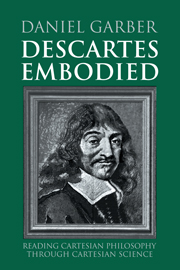Book contents
- Frontmatter
- Contents
- Acknowledgments
- Abbreviations, Citations, and Translations
- Introduction
- Part I Historiographical Preliminaries
- Part II Method, Order, and Certainty
- Part III Mind, Body, and the Laws of Nature
- 7 Mind, Body, and the Laws of Nature in Descartes and Leibniz
- 8 Understanding Interaction: What Descartes Should Have Told Elisabeth
- 9 How God Causes Motion: Descartes, Divine Sustenance, and Occasionalism
- 10 Descartes and Occasionalism
- 11 Semel in vita: The Scientific Background to Descartes' Meditations
- 12 Forms and Qualities in the Sixth Replies
- Part IV Larger Visions
- Sources
- Index
12 - Forms and Qualities in the Sixth Replies
Published online by Cambridge University Press: 10 November 2009
- Frontmatter
- Contents
- Acknowledgments
- Abbreviations, Citations, and Translations
- Introduction
- Part I Historiographical Preliminaries
- Part II Method, Order, and Certainty
- Part III Mind, Body, and the Laws of Nature
- 7 Mind, Body, and the Laws of Nature in Descartes and Leibniz
- 8 Understanding Interaction: What Descartes Should Have Told Elisabeth
- 9 How God Causes Motion: Descartes, Divine Sustenance, and Occasionalism
- 10 Descartes and Occasionalism
- 11 Semel in vita: The Scientific Background to Descartes' Meditations
- 12 Forms and Qualities in the Sixth Replies
- Part IV Larger Visions
- Sources
- Index
Summary
The Sixth Objections, like the Second Objections, were collected by Father Marin Mersenne, and purport to represent the views of the group of philosophers and theologians who belong to the so-called Mersenne circle. The very first objection that Mersenne and his friends make to the Meditations in the Second Objections concerns the real distinction between mind and body; Mersenne and his friends simply do not understand how Descartes' arguments exclude the possibility that thought is not a kind of motion, and why a body cannot think (AT VII 123). Descartes, of course, attempts to answer this question in the Second Replies (as well as in the Third and Fifth Replies), but evidently not to Mersenne's satisfaction. For in the Sixth Objections, the very same question is raised yet again (AT VII 413). Mersenne goes on to suggest that even the Church Fathers believed that thought “could occur by means of corporeal motions” (AT VII 413). The Sixth Objections ends with an appendix and a letter “from some philosophers and geometricians to M. Descartes” in which these very same doubts are voiced again:
However much we ponder on the question of whether the idea of our mind (or a human mind), i.e., our knowledge and perception of it, contains anything corporeal, we cannot go so far as to assert that what we call thought cannot in any way belong to a body subject to some sort of motion. … We have read what you have written seven times, and have lifted up our minds, as best we could, to the level of the angels, but we are still not convinced.
- Type
- Chapter
- Information
- Descartes EmbodiedReading Cartesian Philosophy through Cartesian Science, pp. 257 - 274Publisher: Cambridge University PressPrint publication year: 2000
- 2
- Cited by



